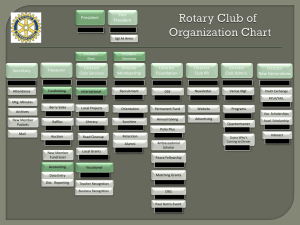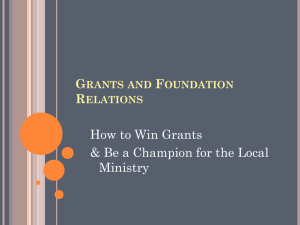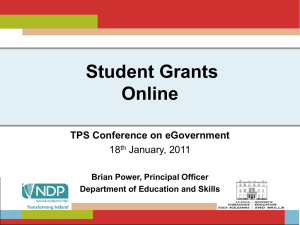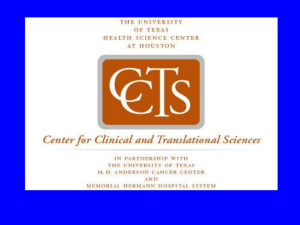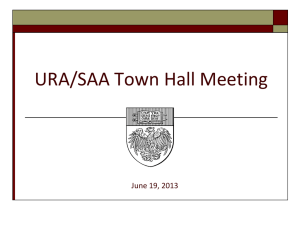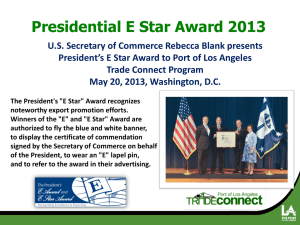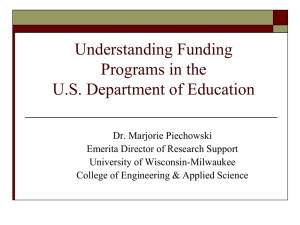Grants Writing for Early Childhood Educators
advertisement
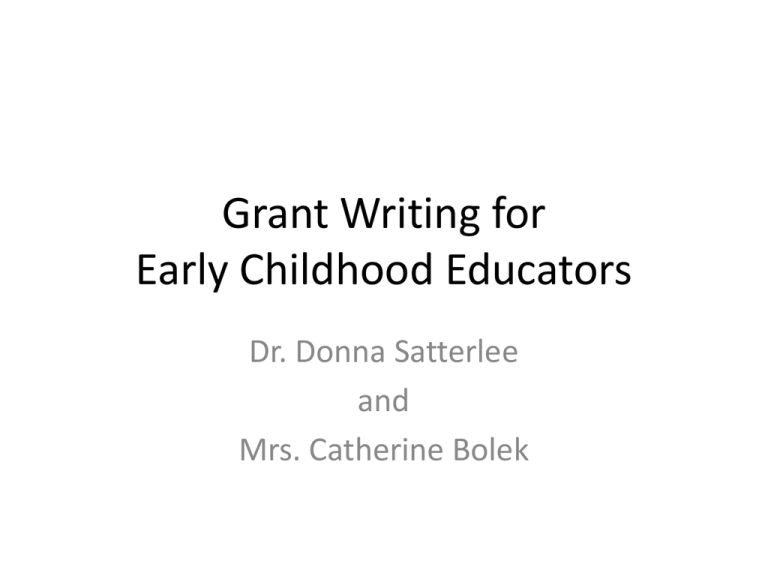
Grant Writing for Early Childhood Educators Dr. Donna Satterlee and Mrs. Catherine Bolek Presenters • Dr. Donna Satterlee, Senior Lecturer, has received grant awards to support the University of Maryland Eastern Shore’s Child Development Education Program. • Mrs. Catherine Bolek, Director of Sponsored Research and Programs at the University of Maryland Eastern Shore with more than 30 years of grant writing and administrative experience. Contact Information • Dr. Donna Satterlee – djsatterlee@umes.edu • Mrs. Catherine Bolek – csbolek@umes.edu Access to PowerPoint Slides • You can assess the slides at • www.umes.edu/osp - right side of the screen. • Look for “Grant Writing for Early Childhood Educators.” Raffle • 4 hours of free grant consulting • Complete raffle form, fold several times, and place it in the bowl. • NOTE: We are not selling any services. This is a donation of time to assist a colleague who is new to the world of grantsmanship. Relaxed Mode • We invite your questions and comments. • Please feel free to call for a break. • If you have additional information, please share. • Get comfortable. Mix of Skills and Experience • Because the audience is made up of a mix of professionals including single day-care providers, owners of large day-care facilities, university faculty, etc., we have tried to cover a wide base of general grant writing information. • If we miss something, let us know. Exception to the Rule! • We are going to speak in general terms about what is the most likely experience of a grant writer, recognizing that exceptions exist in every field. Topics • Preparing to be a grantee. • Selecting a project (e.g., research, program). • Discussion of funding mechanisms and ramification of accepting an award. • Identifying funding sources. • Preparing the application. • Surviving peer review process. • Administering an award. • Reapplying when unsuccessful. Preparing to Be a Grantee I • Is my organization a good candidate for a grant award? – Fiscal Health • Vetted cost accounting system • Current audit report • Grants management history – HR Policies in line with government requirements • • • • Drug free work place American with disabilities Lobbying Non-discrimination Preparing to Be a Grantee II • Personnel with the right qualifications – Training – Experience – Certificated • Certificates and regulations in place • State and local government requirements • Professional requirements Preparing to Be a Grantee Part III • Am I the right person from my organization to be the program manager (Principal Investigator)? – Education – Specialized training – Prior directly related training • Do I have the time to prepare a competitive grant application? – What are my current commitments? – What happens if there are unexpected problems? – Adequate staffing? • Do I have the necessary resources to complete the application? – Can I do electronic submission of an application? – Support from external sources (e.g., high school volunteers)? Preparing to Be a Grantee Part IV • Program Grants – Education – Services – Enhancements – Training • Research – Survey – Experimental studies Research Projects • Data driven projects (e.g., pre and post test assessment of cognitive skill development) – Requirement for human subjects protection. – Written informed consent. – Parental consent in the case of a minor. – Research protocol reviewed by an institution review board with NIH assurance. – Obtain courtesy review by a local university, if your organization lacks such a committee. – Responsible conduct of research training. Non-Research Projects • Not a data driven project – Have fewer compliance and reporting criteria. – Project examples, curriculum improvement, after-school care, purchase of equipment and supplies, staff training, site visits. Preparing Your Organization to be a Grant Recipient • Registration with grant.gov (federal) • Registration with federal contractor site (CCR) • Registration with data university numbering system (DUNS) • Obtain an employee ID number (EIN) nonprofit • Taxpayer ID number (TIN) for-profit • Learn individual state requirements Eligibility • • • • • 501 (c ) 3, government entity, or for-profit status Proof of financial stability (e.g., audit report) Sufficiently capitalized Right mix of training and experience Legal status – Requirement for certification – Insurance – Policies and guidelines (e.g., ADA, Drug Free Workplace) – Licensing Cost Accounting System and Capitalization • Does your organization have the ability to track all expenditures? • Does your organization have the funds to pay for project costs until you are reimbursed by the funding agency? • Can your organization guard against comingling of funds? Indirect Cost, Cost Sharing, Matching Funds • Indirect Cost – administrative funds awarded in addition to direct costs. More on this later. • Cost Sharing – a contribution made by your organization to the direct cost of a project. For example, 10% of your labor hours. • Matching funds – a dollar contribution made by your organization. For example, a 50% to 50% match. Indirect Costs • Does your organization have an indirect cost rate? • Indirect costs are those costs associated with the conduct of a project not covered by the direct cost. For example, janitorial services, purchasing and human resources departments, lights and air conditioning. Next Level of Discussion • Understanding funding mechanisms. – Grants – Cooperative agreements – Contracts – Gifts and donations – Volunteer assistance Understanding Funding Mechanisms • Various funding mechanisms carry different legal and regulatory requirements. • Understanding these requirements keeps us out of trouble with funding agencies and foundations. • Also, understanding the obligations up front reduces problems during the period of performance and close out. What is a Grant? • Funds provided by an external source (e.g., state government). • Awards come with terms and conditions. • Federal grants are subject to strict laws and regulations. • Grants are best level of effort mechanisms. • Grants are generally cost reimbursable mechanisms. Your organization receives the funds after the fact. Other Funding Mechanisms • Cooperative Agreements – a grant with more restrictions • Contracts – Contracts are legal, binding mechanisms requiring performance, timelines, and cost restrictions. – Use caution when entering into a contractual agreement. • Gifts and Donations – usually no formal requirements and few restrictions on spending. Other Sources of Support • Government Benefits • Rural Development Loans and Grants • Scholarships and Fellowships What will a Grant Award Support? • • • • • • • Salaries and fringe benefits Materials and supplies Equipment Travel Consultants Sub-contracts Administrative costs (indirect costs) Grants.gov • Most grants being submitted to the Federal government, are submitted through the internet site know as grants.gov. • Organizations must register with grants.gov. • You can download the electronic application and submit it to your authorized representative. For universities, the Office of Sponsored Programs will be the authorizing representative. Since Everyone Cannot Agree • Several federal agencies opted out of the grants.gov service. – For Example • The National Science Foundation has Fastlane • The National Atmospheric and Space Administration has NSPIRES. • Federal Emergency Management Administration has a “mystery system.” – NOTE: Instead of making the process simpler, the electronic application is more time consuming and can fail at the last minute. Foundations are Moving to Electronic Applications • Foundations like the idea of electronic applications, saves time and improves management of hundreds of documents. • Unfortunately, there is no common format. • Many electronic forms cannot be opened using browsers such as Chrome, Foxfire, Mozilla, and in a few cases even, Google. • Several foundations ask for the files in PDF and/or require an acrobat writer to complete the application. Human Subjects Protection • All grants involving data collection for the purpose of evaluating program outcomes (e.g., weight loss, improved nutrition, substance about prevention), must be reviewed by an authorized Institutional Review Board to ensure the protection of subjects of research. • Check out the Belmont Report and assurance requirements located at www.nih.gov. Internal Review and Sign-Off Process • Be sure that your organization is on board with your plans. • Know the internal process for approving applications. • Seek the help of those with more experience. • When possible, pull together a team including an editor and an accountant. Assess Your Strengths and Weaknesses • What talents are you bringing to the table? • Are your colleagues and others involved in the proposed effort the correct team? • Identify weaknesses (e.g., lack of financial expertise) • Identify strategies to address any weaknesses. The National Economy – Receiving a Grant in Tight Times • Most foundations rely on interest payments and donations as their major source of revenue. • Government agencies rely on congressionally approved budgets. • Private Sources, including the business sector, rely on employee contributions. – What does this mean to you? What Can You do to Offset This Situation? • • • • Lower expectations Prepare more applications Prepare more competitive applications Work collaboratively with agencies and organizations with similar goals • Prepare regional application with experienced partners • Develop expertise in locating the best match for your organization. Finding a Funding Source • • • • • • • Grants.gov (federal only) Foundation Centers.com Community of Science Googling for Grants Going to the Ivy League for help State agencies Professional organizations • Refer to Handout Googling for Grants • www.google.com • Access to the World – Search string • • • • • • Grants for early childhood education Grants for pre-schoolers Grants for preschoolers Grants for nursery schools Grants for day care facilities Funding for early childhood training – Refer to handout for a list of potential funding sources Working the Ivy League • www.yale.edu/researchadministration • http://vpf.web.harvard.edu/osp • http://web.princeton.edu/sites/TreasurersOfice/Bud get/SponsoredResearchAdministration • http://www.research.psu.edu/osp/index.html Funding Databases • IRIS or SPIN – commercial databases available at many universities – search 100,000 of opportunities • MOLIS – Services for minority institutions • Community of Science – Funding opportunities for the sciences • National Library of Medicine – Health related funding sources (mainly research-based) • Grants-alert – Not-for-profit information Other Sources of Funding Information • American Association of Grant Professionals found online at grantprofessionals.org. • Check with the organizations you are a member of such as NAEYC. • State, county, and local agencies. • Local community foundations. • Animal clubs (e.g., Elks, Moose), they provide a % of the proceeds from gambling events. Who to Stay Away From • Non-profit organizations, in general, have a URL address ending in org and edu; government uses gov. • Commercial sources have a URL address ending in net and com. – These commercial sources are trying to sell you something or obtain private information on you or your organization. – Typically, you can find this information on your own. Reading the Program Announcement • • • • • • • Print the announcement. Note due date. Check eligibility criteria. Look for special requirements. Call the funding source if you have questions. Check with your administration for approvals. Read the announcement a second time and make margin notes of actions you will need to take to complete the application. Making the Decision to Apply • Does the announcement speak to your need(s) and expertise? • Do you have sufficient time and resources to prepare a competitive application? • Are all the necessary team members on board and do they have the time to provide assistance? • Should you wait until the next round? Ready to Write • Planning – What do you need the grant for – be very specific? – Who will work on the application? – Do you need external support? – Develop a timeline and stick to it. – Have you notified all partners to the project? – Will you need letters of support and/or commitment? Concept Development and Content Requirements • Develop a clear statement of need. – The statement must be clear, convincing and compelling. – Collect background data on the need you are addressing (e.g., a community-based needs report). – In some cases, you will need references from the research literature. – In other cases you will be required to use evidence or research-based interventions. Typical Proposal Sections • • • • • • • • • • • Abstract Statement of need Target population Goals/objectives Program Description Evaluation plans Timetable Key personnel Suitability plan Reporting Budget and budget justification Common Attachments • • • • • • Resumes Letters of support and/or commitment Audit report List of board members References Evaluation forms Pre-Proposal Activities • Rereading the program announcement (sometimes referred to as a “request for proposal”). • Is a letter of intent required? • Will you need letters of support or collaboration? • Will there be a need for sub-awards? • Are cost-share or matching funds required? • Are indirect costs allowed? Contacting the Funding Source • If the source is local, arrange for a visit, it may save you both time and effort. – Bring a one page summary with goals, expected outcomes, and projected costs. • For funding sources that are not local, call or email your questions. Attending Pre-proposal Meetings • Can you afford the cost of travel to the meeting? • Can you attend using an electronic media? • Prepare your questions in advance. • Take notes. • Federal agencies generally provide a transcript of the meeting (contracts only) for your use when preparing the application. Letter of Intent • Very brief statement including working title, program announcement number, goals, approach and contact information. • The letter is used by peer review administrators to determine the number of applications they will need to process and not to make judgment about the quality of the proposed effort. Understand the Rules of the Grant Game • Tailor each application to meet the specific requirements of the program announcement. • Make the application easy to read. Peer reviewers may be assigned 5 or 6 proposals at a time and can’t take the time to figure out what an applicant is trying to say. • Be positive and optimistic in your writing style. Avoid the Big No Nos • Failing to follow directions. • Applying for projects beyond the teams experience. • Asking for too much money or too little money to complete the project. • Applying blindly. • Not applying at all when you are well qualified. Scheduling Your Time • Create a timeline for proposal development. – Read the program announcement. – Contact others involved in the project. – Agree on Writing Assignment for materials gathering. – Establish a deadline for drafts 1, 2, 3. – Determine the drop dead date. Selecting the Editor • Not your mother, spouse or best friend. • Select someone with the skill, time and enthusiasm to carefully read and critique your manuscript for: – Coherence and clarity – Missing or overlapping information – Inconsistencies – Compelling argument Establishing Credentials • List the relevant past history of your organization. – How many years in operation? – How many employees? – What type of credentialing? – What type of insurance? – How are background checks handled? – Audit reports and accounting information?? Writing the Proposal • Phase 1 – One strategy for creating your proposal content is to download the application instructions and save them as a word processing file. For example, the funding source provides the guidelines and format that you have downloaded from their site and save. • NOTE: Saving the growing proposal on at least two sites (e.g., travel drive) avoids problems with crashes. Writing Cont’d • Phase II – In one sitting, use the “fill in the blank approach” maintaining the funding agency’s headings for each section and paragraph. • Even if it is only one sentence, try to complete something in each section. Remember, you don’t have to go in order, complete the sections that are easiest for you first. • Now go back and add questions, notes, names and phone number of people you need to contact to complete the application. • Save frequently. • Print out a hard copy when you have completed each writing session. Writing Cont’d • Phase III – Continue with completing the application until done. • Edit and then have someone else edit the application for typos, contradictions, missing information, and inaccuracies. Ask them to be tough! • Check the budget and budget justification and then have a second person run your numbers, just to be sure. Writing Cont’d • Phase IV – Rout the completed application for internal review. • Arrange for submission (e.g., electronic, mail, email attachment). • Confirm receipt of the application. • Create a file system for future reference and store a hard copy with all related documents. • Light the candles! Application Content • Freedom of Information Requests – may take 6 weeks, cost you money, come so redacted that you don’t benefit from the content, or come three days after your submission deadline. • Good sources for sample applications • http://www.imls.gov/applicants/sample.shtm • http://www.npguides.org/guide/sample_prop osals.htm Carefully Review Evaluation Criteria • Most program announcements contain the criteria to be used by the peer reviewers. – Technical understanding/approach -35% – Capabilities and experience – 25% – Evaluation approach – 25% – Facilities and equipment – 15% • Have a section that uses headings and provide your evidence, as appropriate. Writing Tips • • • • • • • • • Take care with your language. Be kind to the reader. Use headings, charts and graphs. Use logical transitions. Be enthusiastic. Avoid ambiguous language. Support your statements with facts. Do not rely on self-editing. Craft a good, interesting story that sells your ideas. • Don’t make excuses. Format • Always, always, always use the format provided in the application instructions. • Creating your own format is generally a bad idea, because the peer reviews have been trained to follow the application instructions. • Be sure to follow instruction for font type and size, margins, and other format instructions. Two More Words on Format • You don’t like the format, you have a better idea. Too bad, stick with the posted format. • A confused peer reviewer, is an unhappy reviewer and unhappy reviewers give poor scores!@#$%!!!! Problem Sections • You are very likely up-to-speed in your field and don’t need a lot of preparation work to complete aims, goals, objectives, and even approaches. • Evaluation, sustainability, key personnel, budget and budget justification sections, maybe more problematic. Evaluation • Focus groups (identifies trends). • Surveys (least effective in terms of scientific accuracy). • Formative and summative (simple and quick, gives you a good picture of what’s happening). • Pre- and post-test assessment (more complicated, but more robust). I’m Only Collecting Outcome Data • Sorry, if you have a grant award and are collecting data for the purpose of publishing or presenting the data at a conference, you must obtain informed consent from the parents or guardians of minors. • Your organization may have an Institutional Review Board that reviews and approves research protocols. Sustainability Language • The University is committed to this project and will continue to support these efforts using a mix of University funds and continuation grant funds. A letter of commitment can be found in Attachment C. Key Personnel Sample Language • Dr. Miranda Smith, Director of the Early Childhood Center, will serve at 25% time to carry out the day-to-day management of the project. Dr. Smith has the requisite training and directly related skills to conduct the proposed effort having successfully managed the Center for the past 18 years. Dr. Smith will hire the teachers using established Center hiring criteria, provide supervision, hire a consultant to conduct the evaluation, prepare reports and meet with the foundation during the annual assessment seminar. In addition, as warranted by the data, she will prepare manuscripts for publication in the scholarly literature. Her resume can be found in Attachment B. • Teachers will be recruited from the local community to serve at 50% time during the project period. Teachers must be certified special needs educators and pass state required mandates including finger printing. Budgets Can Be Tricky • Direct Costs - Those costs that are needed to conduct the proposed project. • Personnel, fringe benefits • Other Direct Costs – Non-personnel costs. • Materials, supplies, consultants, travel, renovation • Indirect Costs (usually, restricted to large institutions doing business with the federal government). Indirect Cost Agreements • Large organizations, such as a university, submit a cost proposal to the federal government on a periodic basis. • In turn, the federal government determines the cost of doing business and based on this determination establishes rates. For example, the University of Maryland Eastern Shore rates are 52% of salary and fringe benefits for on campus work, 21% for off campus work, and 9% for Inter-governmental Personnel Act employees. Ethical Issues • Protection of human subjects of research – Confidentiality – Informed consent – Custody of data – Privacy Act • Misconduct in Science – Plagiarism – Falsification – Fabrication – Disclosure Problems – Negligence – Self-deception Notes on Budgets • Build your budget as you prepare the application. Every time you write a section where costs are involved, make a matching note in the developing budget. • When constructing a budget, be very thoughtful about how you are going to spend funds requested. Some funding agencies do not allow for major re-budgeting post award. • Most governmental grants are cost reimbursable mechanisms. That means, you spend your organizational funds and bill the government agency after the fact. • If you are new to grantmanship, meet with your organizations grant accountant and become acquainted with the grants management process. It’s never too early to become a knowledgeable consumer of grant management information. Budget Personnel Level of Effort • Director 25% • Teachers (4) 50% • Fringe Benefits (32%) Subtotal Other Direct Costs • Materials and Supplies • Consultant Subtotal Indirect Costs (52% salary & fringe Benefits) Total Total $ 25,000 $100,000 $ 40,000 $165,000 $ 45,000 $ 5,000 $ 50,000 $ 85,000 $300,800 Budget Justification • Personnel – Director will work 25% time on the proposed effort serving as the dayto-day supervisor to project staff, report preparation, evaluation analysis, and meetings with the foundation. – Four teachers will work 50% time on the proposed effort providing daily training sessions to children with special needs. • Materials and Supplies – Books, calculators, and other assistive technology will be purchased for the 50 students who will be participating in the program. • Consultant – An expert consultant will be hired to develop evaluation instruments and conduct the evaluation . The consultant will comply with Institutional Review Board requirements. Budget No Nos • • • • • Mathematical errors. No justification. No clear role for personnel listed. Budget exceeds allowable limit. Budget is insufficient to cover proposed expenses. • Unallowable items or costs. Cost Sharing and Matching Funds • These funds are provided by your organization and must be carefully monitored to ensure that the organization makes the correct cost or cost share. • The federal government has stiff penalties for failure to make the cost share or match as stated in the body of the proposal. • Cost share, generally means, a dollar to dollar percentage of the total cost. • Matching funds can be labor hours or other items not covered under an organization’s indirect cost agreement. Review Criteria • Remember most program announcements contain the review criteria to be used by the peer review committee. • Be sure you have amply addressed each element. – Failure to do so can be deadly. Alternative Applications Oral Presentations • You submit a 3 – 5 page summary. • You are selected to make a 20 minute presentation followed by questions from the peer review panel. • You can bring a limited number of slides (e.g., 5). • To Prepare – Ask a colleague to read the summary and program announcement followed by questions on all review criteria. Then do it again. Phased Application • Phase I – Brief electronic form • Phase II – Formal application Site Visits • Reread the proposal the day before the visit. • Select an appropriate location. • Have administrators or appropriate others available to meet with peer reviewers. • Ask about special requirements or needs. • Ask for questions in advance. • Anticipate the funders needs. Grants and Legal Issues • • • • • • • • • • Non-compliance Limitation of liability Termination Insurance Dispute resolution Confidentiality Payment Conflict of interest Financial disclosure Misuse of funds Contracts and Legal Issues • All the issues that come with grant awards, plus the legal requirement to complete the work in a satisfactory manner, within cost and on time. Winning Tips • Address all the requirements no matter how awkward. • Spell out the benefits of your approach. • Use simple, easy to understand language. • Use graphs and tables to strengthen understanding of your approach. • Give the peer reviewers a strong application to defend your request. Peer Review • Most governmental agencies, have committees made up of outside experts, who are given the review criteria and review instructions. • Peer reviewers are assigned multiple applications and asked to prepare a written critique; resulting in a score. • For example, many federal agencies use a scoring systems of 100 (the best) and (500) the worst. • NOTE: Applications that do not meet minimal criteria may not reach the peer review stage, being rejected by staff. Avoiding Fatal Flaws and Common Mistakes • General – Spelling and grammar errors – Sloppy or confusing presentation – Exceeds page limits • Personnel – No prior related experience or training – Unrelated experience or training – Old resume with no up-to-date information • No basis for the proposed work • Uncritical acceptance of the literature Cont’d • Failure to make a case for the importance of the proposed effort. • No rational • Lack of clarity • Objectives and goals don’t match • No evaluation plan • No letters of support • No proof of access to a target populaton When Will You Hear About the Results of the Review Process? • • • • Federal government – 9 months to a year State government – varies widely by agency Foundations – generally 60 – 90 days NOTE: With many agencies and foundations moving to electronic pre-submission notices, you may hear within 30 days about your selection to submit a full proposal. The Award • • • • • Celebrate. Notify appropriate authorities. Obtain a discreet accounting number. Review terms and conditions of award. Review approved budget and enter into negotiations if the approved amount is less than requested. • Initiate work. Award Cycle • • • • • • • Pre-award Award Post award Spending and reporting Changes (e.g., re-budget) Close out Possible audit (keep federal award documents for 7 years post award Scope of an Audit • Cost • Compliance • Performance Issues What Items Does the Auditor Examine? • • • • • • • • • • Salary distribution Fringe benefit rates Travel costs Entertainment costs Contributions and gifts Income Lobbying costs matching/cost share Indirect costs and allocation plan Equipment purchases Subawards Administrative Audit • • • • • • • Financial management system Scope/budget revisions Procurement practices Property management Sub-recipient management Human subjects Misconduct in science Performance Audit • • • • • • Complete and timely reporting Meeting program objectives Program management practices Appropriate use of grant funds Over expenditures Failure to complete the project requirements Audit Process • • • • • • • Interviews during the audit Exit conference Draft audit report Response Final audit report Appeal Audit resolution determination Debarment and Suspension • “There is no kind of dishonesty into which otherwise good people more easily and frequently fall than that of defrauding the government.” Benjamin Franklin Compliance • Responsible Conduct of Science Training • Date Management and Sharing Plans • Office of Management and Budget Circulars (instructions for spending federal dollars) • Protection of the subjects of research • Biosafety requirements • Ethics boards (e.g., conflicts of interest) Patents and Inventions • Who owns the efforts of your work? – University – generally a shared arrangement if a patent is granted. – You if the resulting effort is a book. However, once accepted by a publishing house, they becomes the owners through a contract for payment arrangement. – If the award has been made as a contract, the products of your labors are owned by the citizens of the US. Establish a Discrete Account Number • Particularly for government grants, you will need to establish a separate account number for each award to make it possible to track expenditures. • This practice is a requirement for federal and most state grants. • Co-mingling of funds can lead to penalties and fines. No Joy! • What happens when you do not receive an award? – Ask for debriefing. – What were the strengths and weaknesses? – Was anything missing or confusing? – Is there a list of those who received an award? – What is the next deadline date? Questions • Additional comments for the good of the company. • Many thanks for the opportunity to talk with you today. Thank You • Enjoy the conference.
